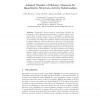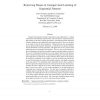275 search results - page 30 / 55 » A Comparison of Pruning Methods for Relational Concept Learn... |
EOR
2008
13 years 7 months ago
2008
Group Technology (GT) is a useful way of increasing the productivity for manufacturing high quality products and improving the flexibility of manufacturing systems. Cell formation...
DIS
2010
Springer
13 years 6 months ago
2010
Springer
Quantitative structure-activity relationships (QSARs) are regression models relating chemical structure to biological activity. Such models allow to make predictions for toxicologi...
ML
2007
ACM
13 years 7 months ago
2007
ACM
In many learning problems prior knowledge about pattern variations can be formalized and beneficially incorporated into the analysis system. The corresponding notion of invarianc...
BMCBI
2004
13 years 7 months ago
2004
Background: In addition to known protein-coding genes, large amounts of apparently non-coding sequence are conserved between the human and mouse genomes. It seems reasonable to as...
IDA
2007
Springer
13 years 7 months ago
2007
Springer
Unsupervised sequence learning is important to many applications. A learner is presented with unlabeled sequential data, and must discover sequential patterns that characterize th...


